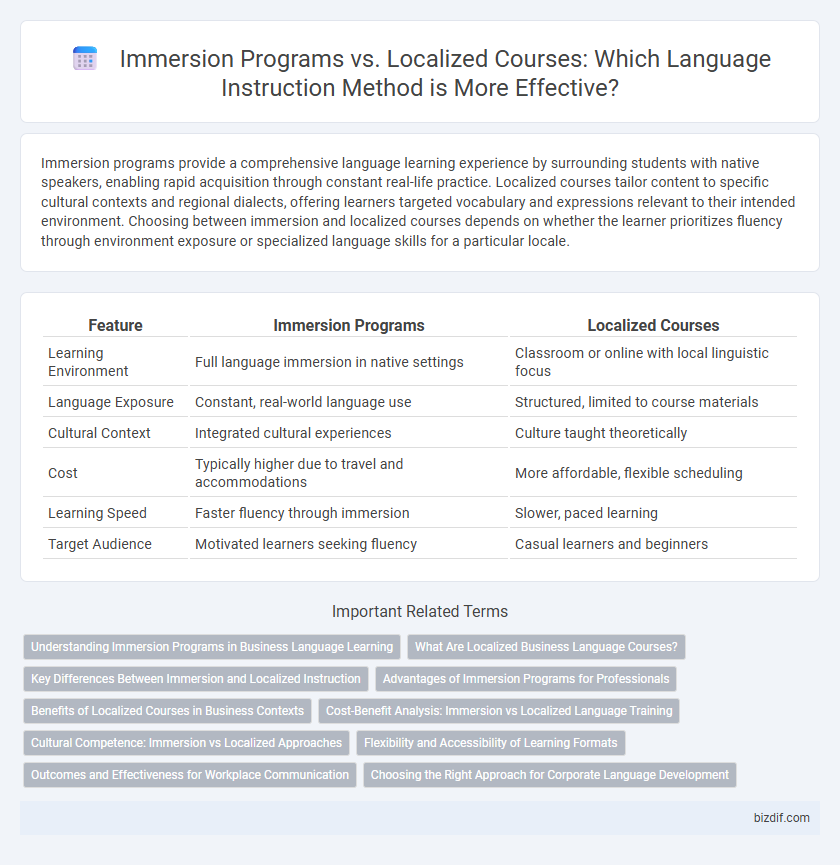Immersion programs provide a comprehensive language learning experience by surrounding students with native speakers, enabling rapid acquisition through constant real-life practice. Localized courses tailor content to specific cultural contexts and regional dialects, offering learners targeted vocabulary and expressions relevant to their intended environment. Choosing between immersion and localized courses depends on whether the learner prioritizes fluency through environment exposure or specialized language skills for a particular locale.
Table of Comparison
| Feature | Immersion Programs | Localized Courses |
|---|---|---|
| Learning Environment | Full language immersion in native settings | Classroom or online with local linguistic focus |
| Language Exposure | Constant, real-world language use | Structured, limited to course materials |
| Cultural Context | Integrated cultural experiences | Culture taught theoretically |
| Cost | Typically higher due to travel and accommodations | More affordable, flexible scheduling |
| Learning Speed | Faster fluency through immersion | Slower, paced learning |
| Target Audience | Motivated learners seeking fluency | Casual learners and beginners |
Understanding Immersion Programs in Business Language Learning
Immersion programs in business language learning provide an intensive environment where learners engage directly with the target language through real-life interactions, accelerating proficiency by fostering practical usage and cultural context. These programs often include situational role-plays and industry-specific vocabulary, which enhance comprehension and communication skills essential for international business. Compared to localized courses, immersion offers deeper linguistic immersion and contextual learning, making it highly effective for mastering nuanced business language and cross-cultural communication.
What Are Localized Business Language Courses?
Localized business language courses tailor instruction to the cultural, professional, and linguistic nuances of a specific region or industry, enhancing communication effectiveness in local markets. These courses incorporate relevant terminology, business practices, and cultural norms to prepare learners for real-world interactions within targeted business environments. Unlike broad immersion programs, localized courses offer customized content that aligns closely with learners' professional goals and regional demands.
Key Differences Between Immersion and Localized Instruction
Immersion programs prioritize full language exposure by surrounding learners with the target language in diverse real-life contexts, enhancing fluency and cultural competence. Localized courses adapt content to the learner's native language and cultural background, focusing on grammar, vocabulary, and comprehension through familiar references. The key difference lies in immersion's direct, immersive experience versus localized instruction's tailored, language-bridging approach.
Advantages of Immersion Programs for Professionals
Immersion programs accelerate language proficiency by surrounding professionals in real-world communication environments, enhancing practical speaking and comprehension skills more effectively than localized courses. These programs foster cultural understanding and contextual learning, crucial for effective international business interactions. Intensive exposure in immersion settings leads to faster retention and fluency, enabling professionals to confidently engage in multilingual workspaces.
Benefits of Localized Courses in Business Contexts
Localized courses in business language instruction enhance cultural relevance by incorporating industry-specific terminology and regional communication styles, improving practical applicability. They foster better engagement and retention among learners by addressing unique market needs and business practices. This targeted approach leads to more effective communication skills crucial for successful negotiations, client relations, and team collaboration in diverse business environments.
Cost-Benefit Analysis: Immersion vs Localized Language Training
Immersion programs often entail higher upfront costs due to travel, accommodation, and intensive instruction but provide accelerated language acquisition through real-life practice and cultural exposure. Localized language courses typically offer more affordable tuition with flexible scheduling but may result in slower fluency progress and less contextual understanding. Evaluating the cost-benefit ratio depends on individual goals, available resources, and desired proficiency speed, with immersion yielding faster results at a premium and localized courses offering economic efficiency with gradual improvement.
Cultural Competence: Immersion vs Localized Approaches
Immersion programs accelerate cultural competence by surrounding learners with native speakers and authentic contexts, fostering intuitive understanding of social norms and idioms. Localized courses emphasize cultural nuances through structured lessons tailored to specific regions, enhancing comprehension of formal customs and regional dialects. Both methods cultivate cultural competence, but immersion offers experiential learning while localized courses provide targeted cultural insights.
Flexibility and Accessibility of Learning Formats
Immersion programs offer intensive, full-language exposure that accelerates fluency but require fixed schedules and locations, limiting flexibility for learners with busy lifestyles. Localized courses provide multiple formats such as online classes, evening sessions, and self-paced modules, enhancing accessibility for diverse learners worldwide. Flexibility in localized courses supports ongoing language practice without geographical constraints, making them ideal for working professionals and remote students.
Outcomes and Effectiveness for Workplace Communication
Immersion programs significantly enhance workplace communication by fostering rapid language acquisition and cultural understanding, enabling employees to navigate diverse professional settings effectively. Localized courses, while more accessible, often focus on region-specific terminology and context, which can limit adaptability in global business environments. Studies show immersion participants achieve higher fluency levels and better problem-solving skills in real-time interactions, leading to improved collaboration and productivity across multinational teams.
Choosing the Right Approach for Corporate Language Development
Immersion programs accelerate language acquisition by placing employees in real-life scenarios, fostering rapid fluency and cultural understanding essential for global business interactions. Localized courses tailor instruction to specific corporate contexts and regional nuances, ensuring relevance and practical application within the company's operational environment. Selecting the right approach depends on factors such as learner proficiency, corporate goals, budget constraints, and desired speed of language mastery for effective communication in international markets.
Immersion programs vs Localized courses Infographic

 bizdif.com
bizdif.com